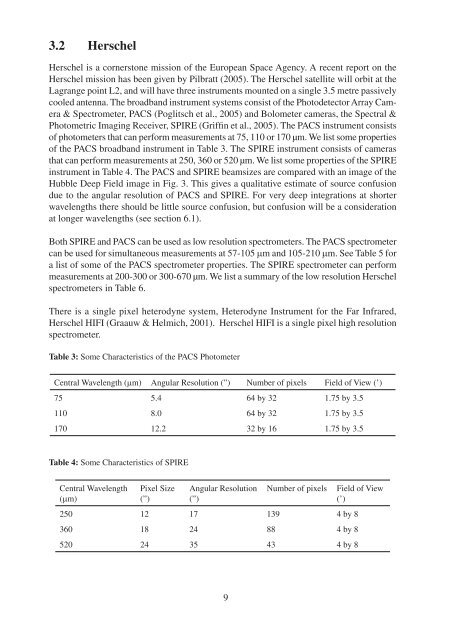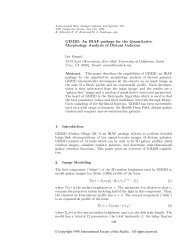4 Comparison of the ALMA and Herschel - ESO
4 Comparison of the ALMA and Herschel - ESO
4 Comparison of the ALMA and Herschel - ESO
Create successful ePaper yourself
Turn your PDF publications into a flip-book with our unique Google optimized e-Paper software.
3.2 <strong>Herschel</strong><br />
<strong>Herschel</strong> is a cornerstone mission <strong>of</strong> <strong>the</strong> European Space Agency. A recent report on <strong>the</strong><br />
<strong>Herschel</strong> mission has been given by Pilbratt (2005). The <strong>Herschel</strong> satellite will orbit at <strong>the</strong><br />
Lagrange point L2, <strong>and</strong> will have three instruments mounted on a single 3.5 metre passively<br />
cooled antenna. The broadb<strong>and</strong> instrument systems consist <strong>of</strong> <strong>the</strong> Photodetector Array Camera<br />
& Spectrometer, PACS (Poglitsch et al., 2005) <strong>and</strong> Bolometer cameras, <strong>the</strong> Spectral &<br />
Photometric Imaging Receiver, SPIRE (Griffin et al., 2005). The PACS instrument consists<br />
<strong>of</strong> photometers that can perform measurements at 75, 110 or 170 µm. We list some properties<br />
<strong>of</strong> <strong>the</strong> PACS broadb<strong>and</strong> instrument in Table 3. The SPIRE instrument consists <strong>of</strong> cameras<br />
that can perform measurements at 250, 360 or 520 µm. We list some properties <strong>of</strong> <strong>the</strong> SPIRE<br />
instrument in Table 4. The PACS <strong>and</strong> SPIRE beamsizes are compared with an image <strong>of</strong> <strong>the</strong><br />
Hubble Deep Field image in Fig. 3. This gives a qualitative estimate <strong>of</strong> source confusion<br />
due to <strong>the</strong> angular resolution <strong>of</strong> PACS <strong>and</strong> SPIRE. For very deep integrations at shorter<br />
wavelengths <strong>the</strong>re should be little source confusion, but confusion will be a consideration<br />
at longer wavelengths (see section 6.1).<br />
Both SPIRE <strong>and</strong> PACS can be used as low resolution spectrometers. The PACS spectrometer<br />
can be used for simultaneous measurements at 57-105 μm <strong>and</strong> 105-210 μm. See Table 5 for<br />
a list <strong>of</strong> some <strong>of</strong> <strong>the</strong> PACS spectrometer properties. The SPIRE spectrometer can perform<br />
measurements at 200-300 or 300-670 µm. We list a summary <strong>of</strong> <strong>the</strong> low resolution <strong>Herschel</strong><br />
spectrometers in Table 6.<br />
There is a single pixel heterodyne system, Heterodyne Instrument for <strong>the</strong> Far Infrared,<br />
<strong>Herschel</strong> HIFI (Graauw & Helmich, 2001). <strong>Herschel</strong> HIFI is a single pixel high resolution<br />
spectrometer.<br />
Table 3: Some Characteristics <strong>of</strong> <strong>the</strong> PACS Photometer<br />
Central Wavelength (μm) Angular Resolution (”) Number <strong>of</strong> pixels Field <strong>of</strong> View (’)<br />
75 5.4 64 by 32 1.75 by 3.5<br />
110 8.0 64 by 32 1.75 by 3.5<br />
170 12.2 32 by 16 1.75 by 3.5<br />
Table 4: Some Characteristics <strong>of</strong> SPIRE<br />
Central Wavelength<br />
(μm)<br />
Pixel Size<br />
(”)<br />
Angular Resolution<br />
(”)<br />
Number <strong>of</strong> pixels<br />
Field <strong>of</strong> View<br />
(’)<br />
250 12 17 139 4 by 8<br />
360 18 24 88 4 by 8<br />
520 24 35 43 4 by 8<br />
9




